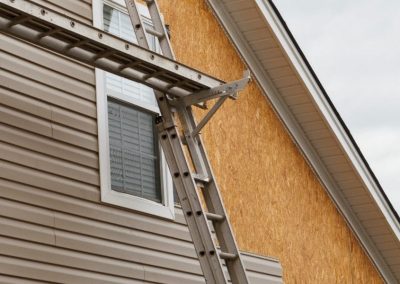Siding Installation: A Comprehensive Guide to Transforming Your Home’s Exterior

Siding is one of the most important components of your home’s exterior. Not only does it help with the aesthetic selling point of your house, but it also protects it in the elements, improves energy efficiency, and raises the overall valuation on your property. Whether you are considering installing siding for the first time or replacing worn-out siding, knowing the process and options available will ensure a prosperous project.
What is Siding?
Siding will be the material put on the exterior of your house or building. It serves both as being a protective layer and as being a decorative feature. Common materials used for siding include wood, vinyl, fiber cement, metal, and stone. Each material possesses its own advantages, costs, and installation requirements.

Why Choose to Install Siding?
Siding provides numerous benefits for your residence, including:
Protection: It shields your home from harsh conditions such as rain, snow, wind, and extreme temperatures.
Energy Efficiency: Properly installed siding can improve insulation, making an effort to regulate indoor temperatures reducing heating and cooling costs.
Aesthetic Appeal: Siding improves the curb appeal of your home, offering a fresh and modern look.
Durability: High-quality siding materials may last for many years, adding long-term value to your house.
Low Maintenance: Some siding materials, like vinyl, are incredibly low-maintenance, requiring nothing but occasional cleaning.
Types of Siding Materials
There can be a wide range of siding materials to pick from. Each material possesses its own distinct look, benefits, and drawbacks. Let’s explore many of the most common options:
Vinyl Siding
Pros: Cost-effective, low-maintenance, obtainable in many colors and styles, resists fading, and will be offering a variety of textures.
Cons: Can crack in extremely cold temperatures and could not be as durable as other materials.
Cost: Typically the least expensive option.
Wood Siding
Pros: Timeless, natural aesthetic, eco-friendly, and may be stained or painted to complement any home design.
Cons: Requires more maintenance (e.g., painting, sealing), susceptible to pests like termites, and may rot or warp or else properly maintained.
Cost: Mid-range pricing, but higher maintenance costs.
Fiber Cement Siding
Pros: Highly durable, fire-resistant, and may mimic wood or stone appearance. Requires minimal maintenance.
Cons: Heavier material, requires professional installation, and may be more expensive than vinyl.
Cost: Higher upfront cost, but long-term durability could make it a good investment.
Metal Siding (Aluminum or Steel)
Pros: Long-lasting, resistant against pests and rot, and low-maintenance. Aluminum siding can also be lighter than steel.
Cons: Can dent easily, especially aluminum, and could not provide the maximum amount of insulation as other materials.
Cost: More expensive than vinyl, but offers great longevity.
Stone and Brick Veneer Siding
Pros: Aesthetic appeal, durable, resistant to fire and pests.
Cons: Expensive and needs professional installation.
Cost: One with the most expensive options.
Siding Installation Process
Installing siding is really a detailed and time-consuming project which will ideally be handled by professionals, however some homeowners might want to tackle it themselves. The installation process typically requires the following steps:
Preparation and Removal
Before installing new siding, a cheap siding or materials are removed, and also the house is prepped. This includes inspecting the current walls for damage, checking for moisture or mold, and repairing any issues.
Installation of Insulation or House Wrap
Once the wall is prepped, insulation or house wrap (a protective barrier that keeps moisture out) is usually installed to improve energy efficiency. This layer allows you regulate the temperature inside the home while protecting against moisture buildup.
Starting in the Bottom
Installation generally begins at the bottom of the property and works upwards. This makes sure that each row of siding overlaps usually the one below it, allowing water circulation down and over surface.
Attaching the Siding
Depending on the material, siding is either nailed, screwed, or fastened with clips. For some materials, including vinyl or fiber cement, specific tools must ensure precise placement.
Trimming and Finishing Touches
Once a lot of the siding is installed, trim pieces are added around windows, doors, corners, and at the roofline. These details not only improve the look but additionally provide extra protection contrary to the elements.
DIY vs. Professional Installation
While some homeowners opt for DIY siding installation, it really is generally recommended to rent a professional contractor. Here’s why:
Experience and Skill: Professional contractors hold the experience to be sure the siding is properly installed and weatherproofed. They are also acquainted with local building codes.
Tools and Equipment: Specialized equipment are often forced to install siding correctly, especially for materials like fiber cement and metal.
Safety: Siding installation could be dangerous, particularly when working on high walls or roofs. Professionals are equipped to handle such tasks safely.
Warranties: Many siding manufacturers offer warranties for professional installations, providing peace of mind in case any issues arise.
Cost of Siding Installation
The price of siding installation can differ significantly depending about the material chosen, the size of the house, and labor costs. On average, homeowners can get to pay any where from $5,000 to $15,000 or more for siding installation. Vinyl siding is usually the least expensive, while stone veneer and fiber cement are with the higher end of the price range.
Factors that Influence Cost:
Material Type: Vinyl and wood are usually the least expensive, while fiber cement, metal, and stone might be pricier.
Home Size: Larger homes require more materials and labor, helping the total cost.
Installation Complexity: If your own home has intricate architectural details, it may require more labor-intensive installation, contributing to the cost.
Siding Installation San Antonio is an excellent way to improve the look, efficiency, and durability of your house. Whether you decide on vinyl, wood, fiber cement, or some other material, proper installation ensures that you get the maximum benefits. With careful consideration of the budget, home design, and long-term maintenance, siding could be a valuable investment that settles for years to come.
